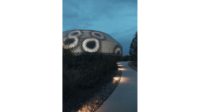Basel, Switzerland
At first glance the Novartis headquarters appears to be an average, though impeccable, corporate facility. Situated on the east bank of the Rhine near the borders of France and Germany in the St. Johann district of Basel, Switzerland, the 50-acre campus is sheltered by trees, old buildings, busy thoroughfares, and the river. But that impression shifts as one approaches the ethereal reception pavilion, designed by Swiss architect Marco Serra, and glimpses the diversity of building forms beyond it.
A work in progress, the Novartis campus is the brainchild of Chairman of the Board Daniel Vasella, who began a collaboration with Italian architect and urbanist Vittorio Magnago Lampugnani in 2000 to develop a 30-year master plan that would convert the property from a manufacturing complex to a center of innovation and commerce, gradually replacing the factories with laboratories and office buildings. In so doing, Vasella aims to alter the company culture by creating a flexible, exciting workplace — most visible through its architecture — to foster employee communication, well-being, and pride of place. Along with Serra (who is also campus-planning coordinator) and Lampugnani himself, Vasella and his project steering committee are hand-picking a virtual “Who's Who” of architecture, with buildings by Tadao Ando, David Chipperfield, Diener & Diener, Frank Gehry, Adolf Krischanitz, Fumihiko Maki, Peter M'rkli, Rafael Moneo, SANAA, Alvaro Siza, and Yoshio Taniguchi already in operation. A lab by this year's Pritzker laureate Eduardo Souto de Moura will open in the fall, and buildings by Juan Navarro Baldeweg, Herzog & de Meuron, Rem Koolhaas, and Rahul Mehrotra are in the works.
Abandon thoughts of a theme park, however. While the individual structures maintain the integrity of the architects, Lampugnani's curatorial approach has assured an aesthetic balance. Based on the existing city grid, his plan incorporates streets and green spaces, and determines building height and footprint, as well as basic interior configurations. Light, too, is a unifying factor, both the sunlight that infuses and reflects off the structures, changing with the time and season, and the general electric-lighting scheme established by the German lighting design firm Licht Kunst Licht — a strategy that facilitates way-finding and allows such divergent buildings as those by Frank Gehry and Fumihiko Maki to shine both as single entities as well as in concert.
People |
Products |

























Post a comment to this article
Report Abusive Comment